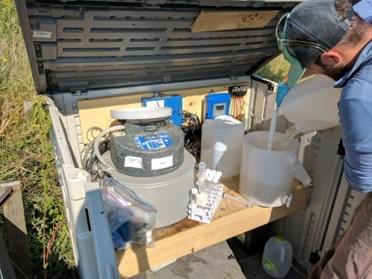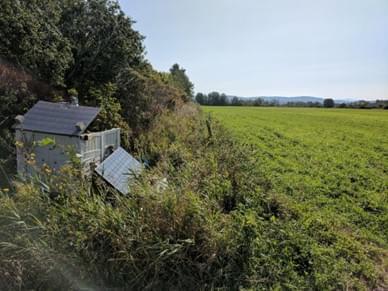Measuring phosphorus contributions from agricultural tile drains in the Jewett Brook watershed
Project Summary:
Over two years from 2016 to 2017, water flow and phosphorus concentrations were measured in 12 tile drain systems in the Jewett Brook watershed, which drains to St. Albans Bay of Lake Champlain. Using a sampling approach that collected water in proportion to the water flow amount, this study was able to estimate the phosphorus load (mass of phosphorus per time) of phosphorus leaving each tile drainage system. The study also put these measurements into context to estimate how much of Jewett Brook’s phosphorus load can be attributed to agricultural tile drains.
Tile (subsurface) drainage on agricultural fields allows timely equipment access, reduced soil compaction, and increased crop yields on fields that would otherwise be too wet to efficiently farm. Tile drainage also significantly alters field hydrology by reducing surface runoff and increasing subsurface discharge. Reports in the scientific literature suggest that discharge from subsurface drainage systems can be a significant source of phosphorus to surface waters.
Key results:
- During the study period, water flows from tile drains ranged from 0 to 3,300 liters per minute.
- Monitoring showed that the mean annual phosphorus load per field area was 0.56 kilograms per hectare. On average, about half of this was in the dissolved form.
- In the Jewett Brook watershed, tile drained lands contribute an estimated 806 kilograms of phosphorus per year, including 355 kilograms of dissolved phosphorus per year.
- This represents an estimated 26% of the total phosphorus load and 16% of dissolved phosphorus load of Jewett Brook. With reasonable confidence intervals, these shares could be as high as 45% for total phosphorus and 29% for dissolved phosphorus.
- Although there were limited statistically significant conclusions due to low sample size, some patterns were evident:
- Phosphorus concentrations and areal load were higher in row crop fields than from hay fields.
- Total and dissolved phosphorus concentrations were higher from fields that had received manure compared to those that had not.
- When manure application coincided with wet weather, very high phosphorus concentrations were observed.
Other takeaways:
Although annual tile water flow was positively correlated with field size, phosphorus concentrations in tile drain water did not vary significantly with field size or water flow. This is contrary to reports from other areas found in the literature review. In addition, there was no clear seasonal pattern in the proportion of phosphorus in dissolved form when using data aggregated from all 12 sites.
This study confirms that tile drains are important contributors of phosphorus in the Jewett Brook watershed, and that particulate and dissolved phosphorus can both be significant fractions of phosphorus in tile drainage water. Tile drains are the focus of several Lake Champlain Basin Program funded research projects in recent years. More results from other studies will be posted on this blog soon.



